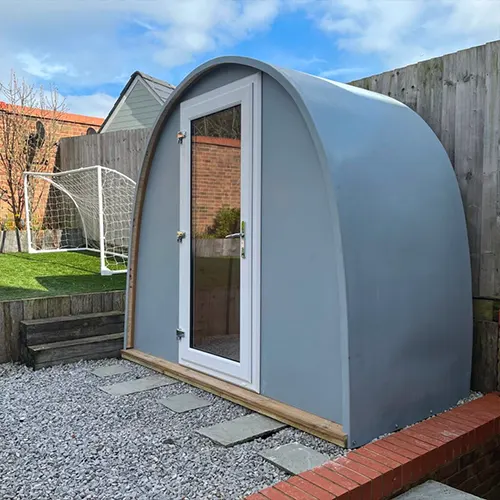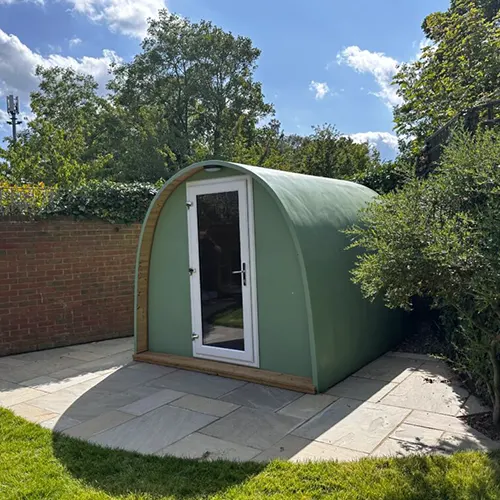What Pod Foundations Work for Your Hully Pod?
|
Worth Reading
When it comes to setting up your Hully Pod, choosing the right foundation pad is an important consideration.
The foundation provides the necessary support and stability for your Pod, ensuring its longevity and proper functionality.
In this article, we will explore various Pod foundation pad options suitable for your Hully Pod and provide recommendations to help you make an informed decision.
Base Sizes for Hully Pods
Before diving into the foundation options, let’s take a look at the base sizes of different Hully Pods.
It’s essential to consider the actual base size of your Pod, allowing for tolerance and providing an additional 50mm (5cm) around the Pod base for any variances.
Here are the measurements of the Pod bases and the suggested minimum Pod pad measurements for each model:

Dory
Our Dory Pods are the smallest Pods available and feature the following base and pad sizes:
- Base size: 2.44 metres wide by 1.235 metres deep (244 cm x 123.5 cm)
- Suggested Pod pad size: 2.54 metres wide by 1.335 metres deep (254 cm x 133.5cm)
Skipjack
Skipjack Pods are slightly larger and more versatile Pods. Their base and pad size are as follows:
- Base size: 2.44 metres wide by 3.035 metres deep (244cm x 303.5cm)
- Suggested Pod pad size: 2.54 metres wide by 3.135 metres deep (254cm x 313.5cm)
Schooner
The Schooner Pod is our largest offering, with a base and pad size of:
- Base size: 2.44 metres wide by 4.235 metres deep (244cm x 423.5cm)
- Suggested Pod pad size: 2.54 metres wide by 4.335 metres deep (254cm x 433.5cm)
When choosing a Pod pad, it’s essential to ensure that it complies with certain requirements.
The pad should be level, firm, and solid, capable of supporting the weight of the Pod without sinking, especially in wet weather conditions.
A slight incline of 1.5cm per 3.5 metres is acceptable for rainwater runoff, but only if the pad is a solid foundation like concrete or a patio.
Keep in mind that the Commando Socket, the mains hook-up connector on the outside of the Pod, increases the overall width of the Pod (footprint) by 3.5cm.
Consider this additional width when planning the placement of your Pod.

What Pod Foundations Work for Your Hully Pod?
Now, let’s learn about what Pod foundations work for your Hully Pod. Below are some of the best examples of foundations to use for your Pod:
Concrete Base
A concrete base is a common and reliable approach, offering strong support for the weight of the Pod.
Concrete is solid, relatively affordable, and easy to lay. If you’re looking to create a new foundation for your Pod, then opting for a concrete base is probably the most convenient option available to you.
It is recommended to have a concrete pad that is at least 10 cm thick to ensure adequate support.
Existing Patio, Block Paving, or Other Stone Surfaces
Another viable option is to utilise an existing patio or any paved or stone surface. As long as these surfaces are level, complete, and free from holes or unevenness, they can be used as Pod pads.
Most patios and stone surfaces are already reinforced, providing a stable foundation for your Pod.

New Patio/Paving Slab Area
If you plan to create a new patio or paving slab area for your Pod, it’s of particular importance to ensure that the foundation is level and firm.
Simply laying paving slabs on grass will not provide enough support and may lead to an uneven base.
Take the time to properly prepare the area before laying the slabs to ensure a solid foundation for your Pod.
Gravel Base
Gravel pads offer several advantages when done correctly.
A gravel base of at least 4 inches of crushed stone can support the same weight as an equally thick concrete pad.
Start by building a lumber perimeter that matches or exceeds the suggested Pod pad measurements.
If the chosen site has a slight slope, the gravel base should be built in a way that compensates for the slope. Using heavy-duty stabilisation fabric beneath the gravel foundation provides additional support and helps prevent weed growth.
Consider using 3/4 inch crushed limestone laid 4 inches thick as the gravel type, and you can finish off the levelling with a pea shingle if desired.

Decking
Decking is a popular choice due to its aesthetic appeal, but you should make sure that you choose the right type of decking.
Composite decking is recommended, as standard wooden decking may have a shorter lifespan.
Ensure that the decking has proper support underneath to handle the weight of your Pod.

Railway Sleepers
If the ground below is adequately prepared, railway sleepers can serve as a suitable pad for your Pod.
Use recently treated sleepers, remove any grass, roots, or debris, dig out and level the space, and create trenches to pack tightly with gravel.
The sleepers should sit on top of these trenches to provide a solid and level pad for your Pod.
Remember that placing your Pod on an unsuitable pad or uneven ground can affect your warranty and lead to issues with doors, windows, and alignment.
If you have any doubts or concerns about preparing your Pod pad foundation, it is recommended to seek advice from skilled or experienced professionals.
This will ensure you enjoy a level, secure Hully Pod for years.
Get the Right Foundation to Properly Install Your Hully Pod
Choosing the right foundation pad is crucial for the proper installation and functionality of your Hully Pod.
Consider the base size of your Pod, select a pad that is level, firm, and solid, and choose from options such as concrete, existing stone surfaces, gravel, decking, or railway sleepers.
Following these guidelines and seeking professional advice can ensure a stable and durable foundation for your Hully Pod, providing you with a comfortable and enjoyable space to relax and unwind.
If you have any questions about your Hully Pod, or would like to book a tour of our workshop, please contact our team or give us a call on 023 8254 6400.






